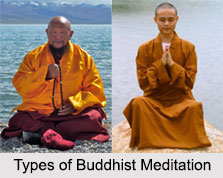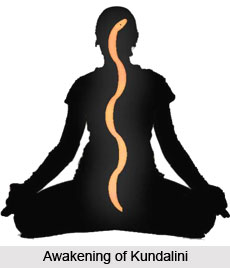 Kula Kundalini is the freed spirit of Kundalini consciousness. Shiva resides in Sahasrara Chakra, while Shakti lies dormant in the triangular yoni, which the shastras also call "kula-kun-dala" or "matri-yoni". "Kula" means ``Shakti" or "power" and "kunda" indicates "yoni". Kundalini, which is even minuter that an atom is coiled three and a half times, and lies inactive within man`s body.
Kula Kundalini is the freed spirit of Kundalini consciousness. Shiva resides in Sahasrara Chakra, while Shakti lies dormant in the triangular yoni, which the shastras also call "kula-kun-dala" or "matri-yoni". "Kula" means ``Shakti" or "power" and "kunda" indicates "yoni". Kundalini, which is even minuter that an atom is coiled three and a half times, and lies inactive within man`s body.
Sahasrara is the dwelling place of Shiva, where Shiva and Shakti live in full harmony. Here the ocean of nectar is found flowing, and just below this is the bindu visarga. It is at this point that the human being rises to a point of achiever, a partial achiever, and finally a non-achiever. At this very place the great Shiva resides in the symbol of light, and when the cover of ignorance is removed, all the three worlds are awakened. This is the place where all the desires arising from the collected karmas, life after life is deposited. The much-coveted "kalpataru" (the imaginary tree which fulfils one`s desires) is also found here. This is the altar where Shiva and Shakti unite.
The power of kula kundalini lies in mooladhara in the form of body consciousness, in swadhisthana in the coarse form, in manipura as the crude form which depicts the sense of smell, in anahata that signifies the sense of touch, in vishuddhi, in ajna transgressing the thought waves of the soul, and finally submerges in the Sahasrara.
When kula kundalini awakens like an angry hissing serpent, body consciousness, inner consciousness and ego are not present and the yogic powers start running behind the yoga aspirant. Now the Guru alerts his disciple because the triumph thus gained can be deprived of temptation. This state is called "Tripura Sundari" because it encloses the gross, subtle and causal body. A person who knows the truth behind this surpasses all the three worlds. The moment kundalini touches anahata chakra, the lotus heart starts to bloom.
If, under the guidance of the Guru, the disciple wish to learn the process of meditation with the mantras "Ka" "Aee" "Ee", "La", "Hrim", then one can master the all-pervading and protective powers of Kameshwari, Aruna, Modini Vimla, Jayeeni, Sarveshi and Kaalini as described in the "Ashtachara". Kula Kundalini is the power of Shiva, which destroys the hunger for life. The Tripura Sundari eliminates the psychic emotions of a yogi, which is three bindus, three triangles, three parallel lines, a mantra with three alphabets, three manifestations, three yonis and three specific powers.
The three bindus of Tripura Sundari are red, white and colorless that signifies self-control, the sense of being and the sense of existence. The first bindu is red in colour and signifies ego-consciousness, the second bindu is white and signifies manomaya consciousness, and the third bindu signifies the formless consciousness, thus having no colour at all. It is recommended that one should meditate on the Kula Kundalini in mooladhara as though the three bindus were smiling faces. This is the method to meditate on the "Manamath Kala", through which one can achieve Shiva consciousness. Now the Guru shall warn the disciple that all this is transient and the benevolence of Tripura Sundari alone is eternal.
Yogis meditate on the Kula Kundalini in the anahata chakra because there the nectar is flowing. By doing this all the elements of sin are abolished. The disciple goes along with the Guru, transgressing earth, fire, water, air and ether elements, remain in pure consciousness. The "Hatha" mantra helps to extinguish the intensity of human feelings. The disciple follows the Guru and eventually will give up the three spheres, the seven realms and the fourteen "bhavanas". Later, he will encounter Brahma (the Creator), Indra (the god of rain), Yama (the god of death) and Kuber (the god of wealth) whom the disciple has to ignore and move along his path.
The first step to attain spirituality is to pacify the Kula Kundalini whose origin is in the yoni, and whose path is along the Sushumna and which unites with Shiva at "brahmarandra". The unbroken day and night japa and steady dhyana brings about the non-dual feeling for your ishta, blessings, living on fruits, total subjugation, wooden silence and severe celibacy, one can even arouse the kula kundalini. For elevating the kula kundalini, one has to chant the "Durga Saptashati" or "Ananda Lahari".
To help the Kula Kundalini rise upwards unobstructed, one have to practice asana, pranayama, mudra and bandha so that the "brahma granthi", "vishnu granthi" and "rudra granthi" can be conquered, and all three gunas has to be subjugated, because Kula Kundalini stands on the corpses in the forms of Mahashakti, Mahakrodha and Avadhoot. In such a condition, only the Guru can give support to his disciple. A Guru should be well educated about the Vamakeswar Gyanaargava and the Tantras before guiding his student in this aspect.
The first stage to raise Kula Kundalini after preparing a sacrificial pit or the "havan kund", the Guru should make immediate offerings to the fire with scented ghee a hundred times, simultaneously the disciple should make offerings a hundred times to the luminous "swayambhu linga" situated in the Kula Kundalini. The Guru makes a sacrificial fire in the north and another opposite it, and with the help of his disciple he should next kindle a fire by attribution called "swayambhu agni". When the sacrificial fire is lit, more firewood should be added to it eventually and while meditating upon Manmatha Kala and Vashini Kala every day, offerings to the fire should be done for hundred times.
When these offerings to the fire are being made, the Guru and disciple should chant the three-bija mantras of "Ka", "Aee" and "EE" to the "panchakshari" (five worlds for chanting mantras). The offerings to the fire should be made with full alertness. Next, the disciple kindles the fire by attribution and manifests the Manmatha Kala in the kindled kund (where the fire is ignited) and concentrates steadily on the ishta devata, (ishta devata is one`s personal god, like a patron saint), next he should chant ``Om, Ka, A, Ee, La, Hrim, Ha, Sa, Ka, Ha, La, Hrim, Sa, Kam, La, Hrim".
While raising the Kula Kundalini, the above-mentioned mantra should be chanted one thousand times. The Guru and disciple perform a powerful "poornahuti" that is the last offering to the fire. Since the container in which the scented ghee for the offering is kept cannot be retained throughout the repeated chanting of the mantras a thousand times. If either of the two (Guru or disciple) looses their concentration while the sacrificial offering, the Yajna becomes prematurely broken. As long as the fire keeps burning, they should both remain in "kumbhaka" and plant their prana in the container where the havan articles are kept, and in the flames of the sacrificial fire, and then rouse their prana with great determination. Till the time when the Guru performs the "poornahuti" the disciple goes on performing the last ritual with great devotion and sincerity.
After that, both the Guru and the disciple should meditate in swadhisthana, on the ishta devata, and become calm. Only yogis can perform these rituals of Kula Kundalini or else the fear of revocation is unavoidable. Only when the Guru and disciple can make their soul free from sin, fearless and pure, can they be successful. An aspirant who is not a brahmachari cannot succeed in this ritual of Kula Kundalini.




















